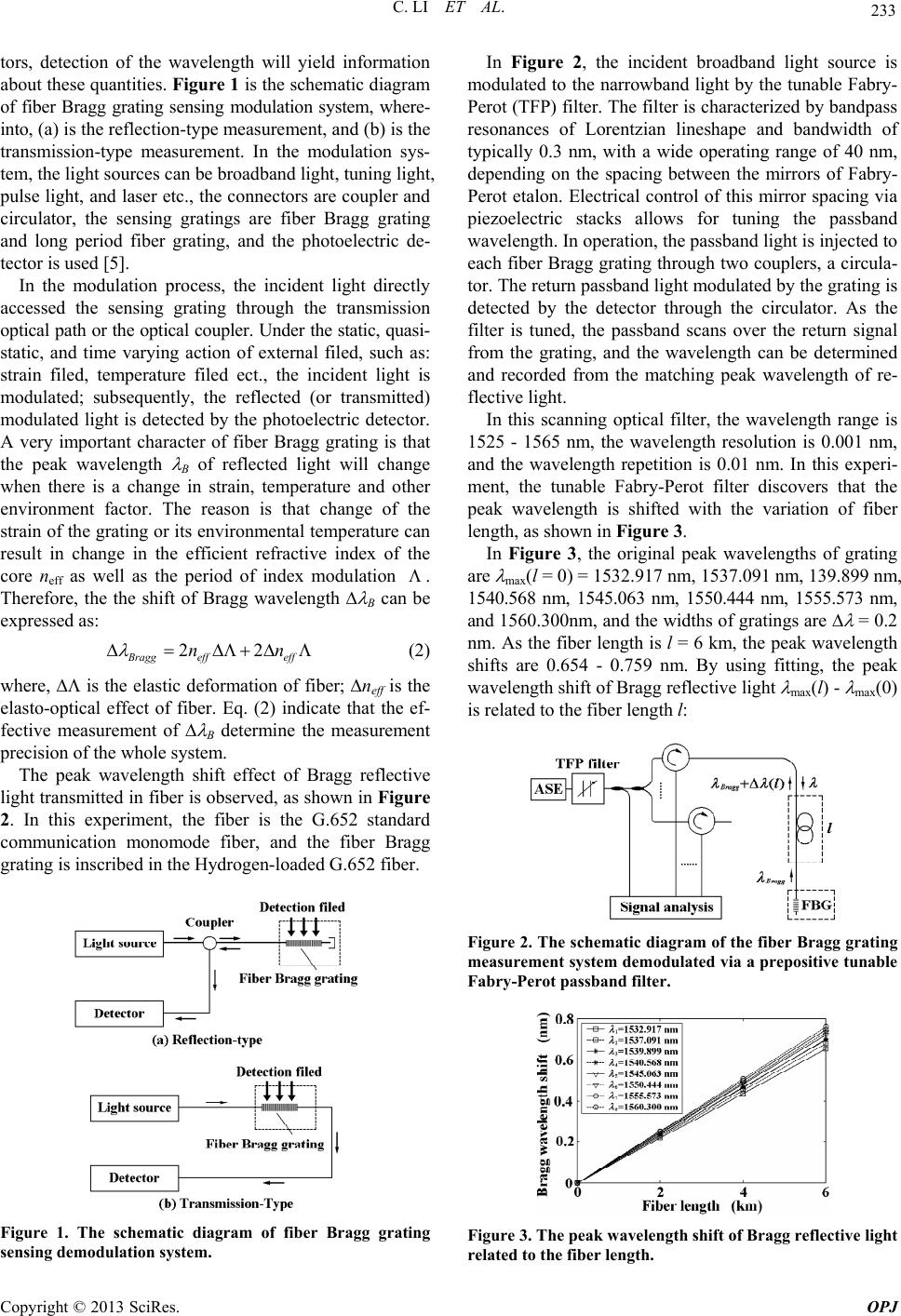
C. LI ET AL. 233
tors, detection of the wavelength will yield information
about these quantities. Figure 1 is the schematic diagram
of fiber Bragg grating sensing modulation system, where-
into, (a) is the reflection-type measurement, and (b) is the
transmission-type measurement. In the modulation sys-
tem, the light sources can be broadband light, tuning light,
pulse light, and laser etc., the connectors are coupler and
circulator, the sensing gratings are fiber Bragg grating
and long period fiber grating, and the photoelectric de-
tector is used [5].
In the modulation process, the incident light directly
accessed the sensing grating through the transmission
optical path or the optical coupler. Under the static, quasi-
static, and time varying action of external filed, such as:
strain filed, temperature filed ect., the incident light is
modulated; subsequently, the reflected (or transmitted)
modulated light is detected by the photoelectric detector.
A very important character of fiber Bragg grating is that
the peak wavelength
B of reflected light will change
when there is a change in strain, temperature and other
environment factor. The reason is that change of the
strain of the grating or its environmental temperature can
result in change in the efficient refractive index of the
core neff as well as the period of index modulation
.
Therefore, the the shift of Bragg wavelength
B can be
expressed as:
22
Bragg effeff
nn
(2)
where, is the elastic deformation of fiber; neff is the
elasto-optical effect of fiber. Eq. (2) indicate that the ef-
fective measurement of
B determine the measurement
precision of the whole system.
The peak wavelength shift effect of Bragg reflective
light transmitted in fiber is observed, as shown in Figure
2. In this experiment, the fiber is the G.652 standard
communication monomode fiber, and the fiber Bragg
grating is inscribed in the Hydrogen-loaded G.652 fiber.
Figure 1. The schematic diagram of fiber Bragg grating
sensing demodulation system.
In Figure 2, the incident broadband light source is
modulated to the narrowband light by the tunable Fabry-
Perot (TFP) filter. The filter is characterized by bandpass
resonances of Lorentzian lineshape and bandwidth of
typically 0.3 nm, with a wide operating range of 40 nm,
depending on the spacing between the mirrors of Fabry-
Perot etalon. Electrical control of this mirror spacing via
piezoelectric stacks allows for tuning the passband
wavelength. In operation, the passband light is injected to
each fiber Bragg grating through two couplers, a circula-
tor. The return passband light modulated by the grating is
detected by the detector through the circulator. As the
filter is tuned, the passband scans over the return signal
from the grating, and the wavelength can be determined
and recorded from the matching peak wavelength of re-
flective light.
In this scanning optical filter, the wavelength range is
1525 - 1565 nm, the wavelength resolution is 0.001 nm,
and the wavelength repetition is 0.01 nm. In this experi-
ment, the tunable Fabry-Perot filter discovers that the
peak wavelength is shifted with the variation of fiber
length, as shown in Figure 3.
In Figure 3, the original peak wavelengths of grating
are
max(l = 0 ) = 1532.917 nm, 153 7.0 91 nm, 139. 899 nm,
1540.568 nm, 1545.063 nm, 1550.444 nm, 1555.573 nm,
and 1560.300nm, and the widths of gratings are
= 0.2
nm. As the fiber length is l = 6 km, the peak wavelength
shifts are 0.654 - 0.759 nm. By using fitting, the peak
wavelength shift of Bragg reflective light
max(l) -
max(0)
is related to the fiber length l:
Figure 2. The schematic diagram of the fiber Bragg grating
measurement system demodulated via a prepositive tunable
Fabry-Perot passba nd filte r.
Figure 3. The peak wavelength shift of Bragg reflective light
related to the fiber length.
Copyright © 2013 SciRes. OPJ